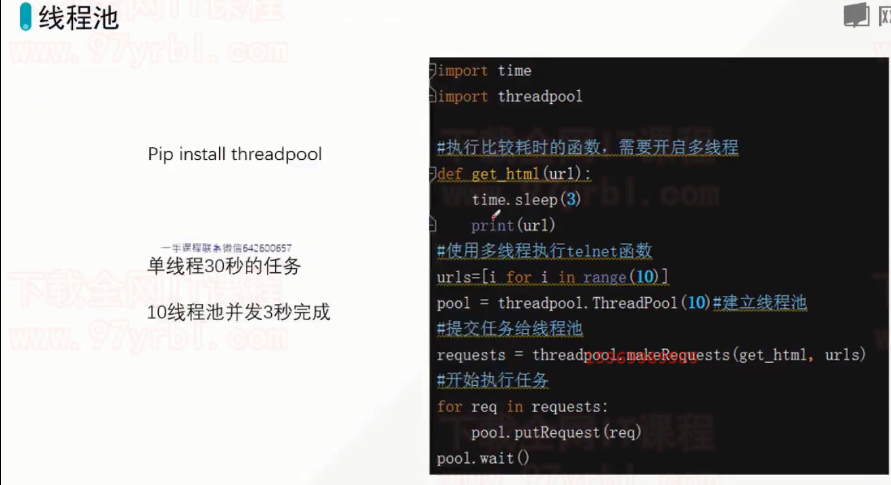
线程池爬取梨视频 简单示例:

#爬取梨视频数据 import requests import re from lxml import etree from multiprocessing.dummy import Pool import random def getVideoData(url): return requests.get(url=url,headers=headers).content def saveVideo(data): fileName = str(random.randint(0,5000))+'.mp4' with open(fileName,'wb') as fp: fp.write(data) print('%s download success \n' % fileName) #实例化一个线程池对象 pool = Pool(5) url = 'https://www.pearvideo.com/category_1' headers = { 'User-Agent':'Mozilla/5.0 (Windows NT 6.1; Win64; x64) AppleWebKit/537.36 (KHTML, like Gecko) Chrome/72.0.3626.119 Safari/537.36' } page_text = requests.get(url=url,headers=headers).text tree = etree.HTML(page_text) li_list = tree.xpath('//div[@id="listvideoList"]/ul/li') video_url_list = [] for li in li_list: detail_url = 'https://www.pearvideo.com/' + li.xpath('./div/a/@href')[0] detail_page = requests.get(url=detail_url,headers=headers).text video_url = re.findall('srcUrl="(.*?)",vdoUrl',detail_page,re.S)[0] video_url_list.append(video_url) video_data_list = pool.map(getVideoData,video_url_list) pool.map(saveVideo,video_data_list)
进程池,线程池concurrent.futures
1.concurrent.futures模块是用来创建并行的任务,提供了更高级别的接口, 为了异步执行调用 2.concurrent.futures这个模块用起来非常方便,它的接口也封装的非常简单 3.concurrent.futures模块既可以实现进程池,也可以实现线程池 4.模块导入进程池和线程池 from concurrent.futures import ProcessPoolExecutor,ThreadPoolExecutor p = ProcessPoolExecutor(max_works)对于进程池如果不写max_works:默认的是cpu的数目 p = ThreadPoolExecutor(max_works)对于线程池如果不写max_works:默认的是cpu的数目*5

1、submit(fn, *args, **kwargs) 异步提交任务 2、map(func, *iterables, timeout=None, chunksize=1) 取代for循环submit的操作 3、shutdown(wait=True) 相当于进程池的pool.close()+pool.join()操作 wait=True,等待池内所有任务执行完毕回收完资源后才继续 wait=False,立即返回,并不会等待池内的任务执行完毕 但不管wait参数为何值,整个程序都会等到所有任务执行完毕 submit和map必须在shutdown之前 4、result(timeout=None) 取得结果 5、add_done_callback(fn) 回调函数

from concurrent.futures import ProcessPoolExecutor,ThreadPoolExecutor from threading import currentThread import os,time,random def task(n): print("%s is running " % os.getpid()) time.sleep(random.randint(1,3)) return n*2 if __name__ == '__main__': start = time.time() executor = ProcessPoolExecutor(4) res = [] for i in range(10): # 开启10个任务 future = executor.submit(task,i) # 异步提交任务 res.append(future) executor.shutdown() # 等待所有进程执行完毕 print("++++>") for r in res: print(r.result()) # 打印结果 end = time.time() print(end - start) ---------------------输出 2464 is running 9356 is running 10780 is running 9180 is running 2464 is running 10780 is running 9180 is running 9356 is running 10780 is running 9180 is running ++++> 0 2 4 6 8 10 12 14 16 18 6.643380165100098

from concurrent.futures import ProcessPoolExecutor,ThreadPoolExecutor from threading import currentThread import os,time,random def task(n): print("%s is running " % currentThread().getName()) time.sleep(random.randint(1,3)) return n*2 if __name__ == '__main__': start = time.time() executor = ThreadPoolExecutor(4) # 线程池 res = [] for i in range(10): # 开启10个任务 future = executor.submit(task,i) # 异步提交任务 res.append(future) executor.shutdown() # 等待所有线程执行完毕 print("++++>") for r in res: print(r.result()) # 打印结果 end = time.time() print(end - start) ------------输出 <concurrent.futures.thread.ThreadPoolExecutor object at 0x00000000025B0DA0>_0 is running <concurrent.futures.thread.ThreadPoolExecutor object at 0x00000000025B0DA0>_1 is running <concurrent.futures.thread.ThreadPoolExecutor object at 0x00000000025B0DA0>_2 is running <concurrent.futures.thread.ThreadPoolExecutor object at 0x00000000025B0DA0>_3 is running <concurrent.futures.thread.ThreadPoolExecutor object at 0x00000000025B0DA0>_3 is running <concurrent.futures.thread.ThreadPoolExecutor object at 0x00000000025B0DA0>_1 is running <concurrent.futures.thread.ThreadPoolExecutor object at 0x00000000025B0DA0>_0 is running <concurrent.futures.thread.ThreadPoolExecutor object at 0x00000000025B0DA0>_2 is running <concurrent.futures.thread.ThreadPoolExecutor object at 0x00000000025B0DA0>_3 is running <concurrent.futures.thread.ThreadPoolExecutor object at 0x00000000025B0DA0>_1 is running ++++> 0 2 4 6 8 10 12 14 16 18 5.002286195755005

import requests import time from concurrent.futures import ThreadPoolExecutor def get(url): print('GET {}'.format(url)) response = requests.get(url) time.sleep(2) if response.status_code == 200: # 200代表状态:下载成功了 return {'url': url, 'content': response.text} def parse(res): print('%s parse res is %s' % (res['url'], len(res['content']))) return '%s parse res is %s' % (res['url'], len(res['content'])) def save(res): print('save', res) def task(res): res = res.result() par_res = parse(res) save(par_res) if __name__ == '__main__': urls = [ 'http://www.cnblogs.com/linhaifeng', 'https://www.python.org', 'https://www.openstack.org', ] pool = ThreadPoolExecutor(2) for i in urls: pool.submit(get, i).add_done_callback(task)#这里的回调函数拿到的是一个对象。得 # 先把返回的res得到一个结果。即在前面加上一个res.result() #谁好了谁去掉回调函数 # 回调函数也是一种编程思想。不仅开线程池用,开线程池也用 pool.shutdown() #相当于进程池里的close和join -------------输出 GET http://www.cnblogs.com/linhaifeng GET https://www.python.org http://www.cnblogs.com/linhaifeng parse res is 17426 save http://www.cnblogs.com/linhaifeng parse res is 17426 GET https://www.openstack.org https://www.python.org parse res is 48809 save https://www.python.org parse res is 48809 https://www.openstack.org parse res is 60632 save https://www.openstack.org parse res is 60632

import requests import time from concurrent.futures import ThreadPoolExecutor def get(url): print('GET {}'.format(url)) response = requests.get(url) time.sleep(2) if response.status_code == 200: # 200代表状态:下载成功了 return {'url': url, 'content_len': len(response.text)} if __name__ == '__main__': urls = [ 'http://www.cnblogs.com/linhaifeng', 'https://www.python.org', 'https://www.openstack.org', ] pool = ThreadPoolExecutor(2) res = pool.map(get, urls) #map取代了for+submit pool.shutdown() # 相当于进程池里的close和join print('=' * 30) for r in res: # 返回的是一个迭代器 print(r) GET http://www.cnblogs.com/linhaifeng GET https://www.python.org GET https://www.openstack.org {'url': 'http://www.cnblogs.com/linhaifeng', 'content_len': 17426} {'url': 'https://www.python.org', 'content_len': 48809} {'url': 'https://www.openstack.org', 'content_len': 60632}

from threading import Thread, currentThread import time import queue class MyThread(Thread): def __init__(self, queue): super().__init__() self.queue = queue self.daemon = True # 子线程跟着主线程一起退出 self.start() def run(self): """ 1、让他始终去运行, 2、去获取queue里面的任务, 3、然后给任务分配函数去执行(获取任务在执行) :return: """ while True: func, args, kwargs = self.queue.get() # 从队列中获取任务 func(*args, **kwargs) self.queue.task_done() # 计数器 执行完这个任务后 (队列-1操作) class MyPool(object): """ 在任务来到之前,提前创建好线程,等待任务 """ def __init__(self, num): # 线程数量 self.num = num self.queue = queue.Queue() for i in range(self.num): MyThread(self.queue) def submit(self, func, args=(), kwargs={}): self.queue.put((func, args, kwargs)) def join(self): self.queue.join() # 等待队列里面的任务处理完毕 def task(i): print(currentThread().getName(), i) time.sleep(2) if __name__ == '__main__': start = time.time() pool = MyPool(3) # 实例化一个线程池 for i in range(4): pool.submit(task, args=(i,)) pool.join() print('运行的时间{}秒'.format(time.time() - start))



